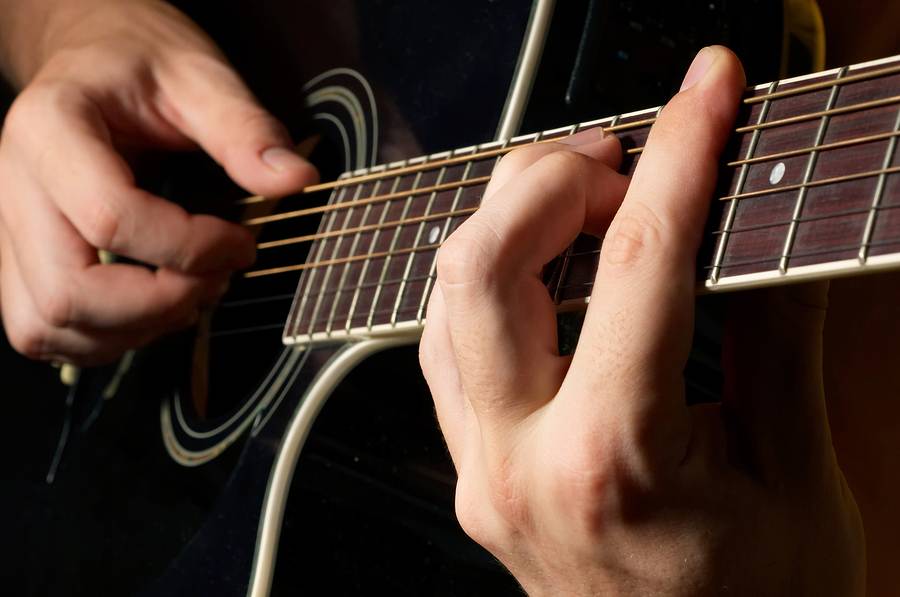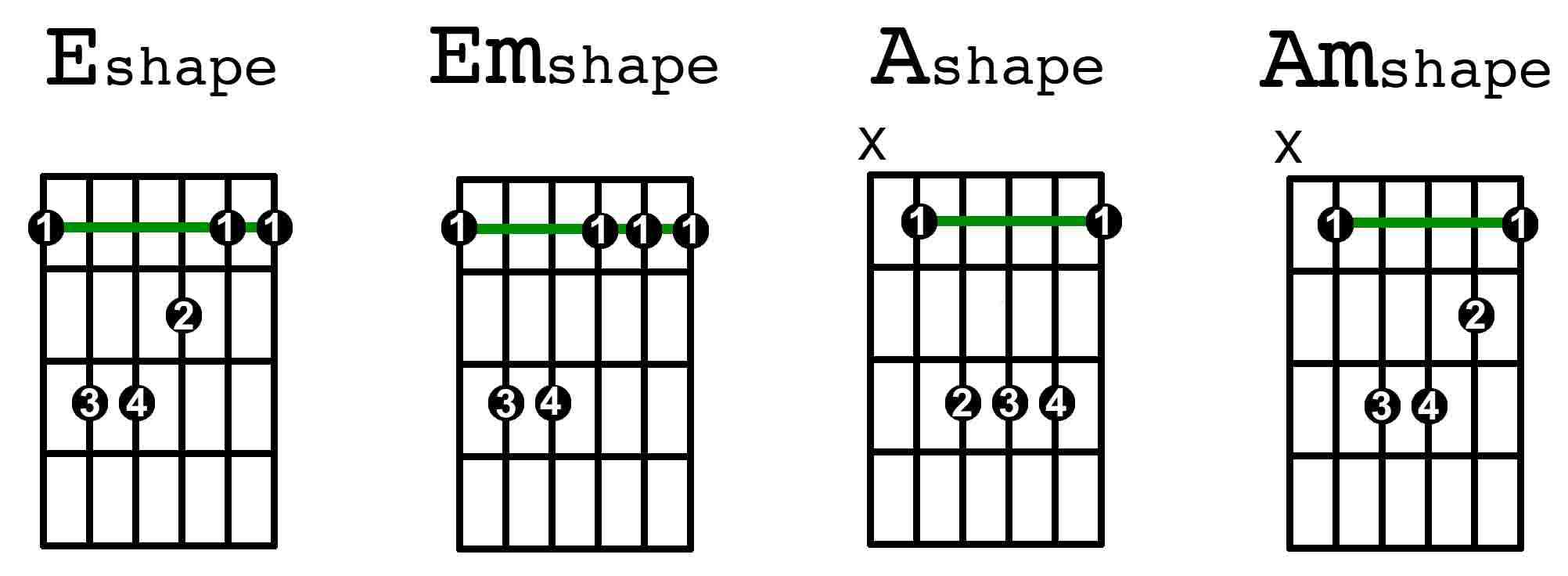September 6, 2023 by Klaus Crow

Once you know how to play open chords like C, A, G, E, D, Em, Am, Dm and different chord forms like sus2, sus4, dom7, min7, add9, etc, it’s time to learn barre chords, also known as bar chords.
Beginner students often ask if it’s really necessary to learn barre chords. Well if you want to become a better guitar player? Yes!
Although you can play lots of songs with just open chords, your playing will also be limited at the same time.
With barre chords you’ll have much more versatility in your playing. New doors will open and cool tricks will come out of the bag. Also switching between chords will become real easy and not to mention a lot of popular songs are played with barre chords.
Learning barre chords can be a little bit overwhelming at first, because they’re hard to play and probably won’t sound that great in the beginning.
When you play a barre chord you might not hear all the notes yet or even any notes at all, but regular practice will get you there. It will take time and effort, but it will pay off big time.
The barre chords are a lot more challenging but also a lot more beneficial, because you can move one barre chord shape all across the fretboard and play the same chord shape in 12 different keys.
I’ll tell you more about that in a minute.
Bar Chord Shapes
In this post I’ll show the four most essential barre chord shapes. While there are many other barre chord shapes, these are the ones that you will probably use most of the time. Also a lot of other barre chords are derived from these shapes.
The 4 bar chord shapes:
- The E major barre chord shape
- The E minor barre chord shape
- The A major barre chord shape
- The A minor barre chord shape

The numbers on the dots in the chord diagrams above indicate the finger positioning:
1 = index finger, 2 = middle finger, 3 = ring finger, 4 = pinky
Let’s take the first chord diagram, the E major shape barre chord for example:
The green line illustrates your index finger. Place it on the first fret across all the strings just like the picture above in the beginning of this post. (the finger in the picture is on the sixth fret, we’re starting on the first fret). Now rotate your index finger slightly back onto its side so you’re not placing it totally flat on the strings and hold down all the strings.
Next put your middle finger on third string, second fret. Your ring finger on the fifth string, third fret and your pinky on the fourth string, third fret. Pick all the strings one by one to make sure each string sounds clear.
If you don’t get a good sound out of each and every string it might be due to some of your fingers touching neighbor strings that keep them from sounding clear or you need some more pressure on the strings using the tip of your fingers.
Moving the Bar Chords
The E major shape barre chord indicates a barre with an E major (shape) chord played with your middle, ring and pinky. When you start the E major shape barre chord starting on the first fret you’re actually playing an F major chord.
The lowest note which you press with your index finger on the sixth string, first fret is the F note, which is also the root note of your chord. This root note defines the name of your chord.
Now if you move up the entire E major shape barre chord a half step (1 fret), you’re playing a F# major chord, because your lowest note (the root note) is now on the sixth string, second fret, which is an F# note. If you don’t know all the notes on the strings check out “Learn the guitar fingerboard thoroughly in 16 days”.
As you can see, you can move up the E major shape barre chord all across the fretboard. Let’s give you another example, if you move up the entire E major shape barre chord another half step (starting with your index finger on the third fret) you get a G major chord.
Move up next is G#, A, A#, B, C, C# D, D#, E and finally back to F on the 13th fret. So you can play each shape barre chord in twelve different keys.
You can also do this with the other chord shapes. The second chord diagram, the Em chord shape is actually an Fm (F minor) chord. The third chord diagram is an A# major chord (or Bb). The fourth chord diagram is A#m (or Bbm) chord.
If you take the third diagram “the A major shape barre chord” you can see the lowest note (the root note) is now on the fifth string, first fret and not on the sixth string because that string is muted.
The root note is an A# note so you’re playing an A# chord (or Bb). Move the entire chord up a half step (1 fret) you get “B”, move up another half step “C”, etc. You get the picture.
Bar Chord Tips
– Practice barre chords on a regular basis. Play songs with barre chords as much as you can.
– Pay attention to how you place your fingers and check if you can find any errors. Replace or move your fingers if necessary. Strive to make all the bar chord notes sound clean and clear.
– Memorize all the notes on the 6th and 5th string, so you’re able to easily find all the barre chords across the fretboard.
“For the things we have to learn before we can do them, we learn by doing them.” ~ Aristotle
Join the Guitarhabits facebook page to keep up with the latest posts, guitar lesson videos, tips, tricks and other news about Guitarhabits.
Hi Klaus sir,
I learned that to become a better guitar player we have to play barre chords and to practice regularly. I’m going to practice these barre chords. Thanks for sharing
Hi Prasana,
Good luck and have patience and persistence.
Best regards,
Klaus Crow
This was something I was dreading while a beginner. But I knew I had to learn these to advance as you pointed out. So I worked on the F shape, pretty much for well over a year. It was not too hard to get the hand to accept the shape and be somewhat comfortable with it. The hardest part was to be able to play it cleanly on a regular basis. I just applied what I had learned when practicing open chords, that with practice it would come. It finally did and then the others came easier. That I knew would be my reward for getting the first one. I kept putting the A shape off thinking that would be tough to fret three strings with my stubby finger. turns out I had that one down within a few days and is my preferred way of playing A now. It really is a a lot more fun to play with barres and feel like I can now open up my playing. After 6 years of messing around I feel like I can sound like someone I would want to listen to. Well almost. Love jack Johnson’s music and now can play a more authentic version.
I remember to have seen friends play these chords some where; but could not tell what they really were. I’m pretty happy to known them much better to day. Ahh! thanks for this magnificent post of yours.
I just down loaded another barr cord chart by another instructor and it is completely reverse from yours. It shows the A barr cord same as your E and the Em the same as your Am. How do I know which “instructor” to believe? This is what makes it hard for us beginners. Who to believe???
Nick:
This is absolutely the correct way.
I tried to play chords, but the skin on my fingers touches the string on the bottom. This then causes it to mute. Any suggestions. Thanks.
HI.
I have been struggling to learn barre chords for a long time. I have been playing for almost 2 years!!! And have not learned barre chords. I thought open chords were okay to live on, but I decided to look them up. Once I did I though “Im screwed.” But once I learned BM barre chord I felt amazing! This website is amazing! <3 Go guitarists!!! WOOHOO!
:) Tess :)
this is awesome thank you Mr Klaus your techniques hasn’t only taught me how to play barre chords with ease,I now can do lots of variations by switching between both open chords and barre chords
The E barre chord and the EM barre chord you show are the F major Barre chord and the F sharp matte chord how can it be the E and Em barre chords
I liked the idea, ” For the things we have to learn before we can do them, we learn by doing them.
I’m with Brian. The E chords are F chords, and the A chords are Bb chords.
Brian and Rob, you are correct about the specific chords listed, but note the careful use of the word “shape”: he’s referring to the overall shape of the chord, not the specific chord that is being played (which is the same shape as an open chord, just transposed higher by use of the index finger as a substitute for the capo). The F chords are based on the E shape, and the B chords are based on the A shape.
To illustrate this, play an E chord, but instead of using fingers 1, 2, and 3, use fingers 2, 3, and 4. Then put a capo on the first fret and play that E shape again. You’re now playing an F chord, because the capo raises the tones of the strings a half step. Now, remove the capo and replace it with your index finger. You’re still playing an F chord, with your 2nd, 3rd, and 4th fingers making an E chord half a step up.
This is what was meant
Can you give a list of good songs to start practicing Barre chords on?
Salutations Mr. Crow ,
As a beginner I found your lesson on the dreaded bar chord. As you said practice, patience and persistence are key as well as positioning of the thumb! Bar chord definitely make it easier to navigate the fretboard. One difference I’ve noticed (for myself) is that the bar chords don’t sound as rich or full as the open chords.
I have now got to grips with E and A shape barre chords . I have learned the root notes on the E and A string up to fret 12. I have found the frets after 12 to be too small for me to make a barre chord .
It seems to be much easier to play barre chords on an electric guitar.
Hey everyone . You can get a hand grip trainer and strengthen for Barre chords . I just used one at the end of every night before bed (That way I still have the rest of the day to play guitar) Just do it till your palm and index fingers cramp. This will get your index and thumb strength for the barre. The dexterity will still need to be learned . But this made my barre chords sound great. Takes a bit of work before bed.